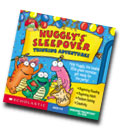|
by Warren
Buckleitner
 Thanks
to excellent new software, computers can actually increase both the quality
and the quantity of children's social interactions. Here are four ways
computers can support emotional development, along with specific software
recommendations for each category. Thanks
to excellent new software, computers can actually increase both the quality
and the quantity of children's social interactions. Here are four ways
computers can support emotional development, along with specific software
recommendations for each category.
1. Software can
facilitate collaboration. Programs that take children on an adventure
create an excellent opportunity for diverse groups to work together.
Freddi
Fish 4: The Case of the Hogfish Rustlers of Briny Gulch
Ages: 3-8
Teaches: interpersonal development, working
in a group, problem solving, and memory skills
Working in small
groups of two or three, children can explore richly illustrated underwater
scenes as they help Freddi Fish and her pal Luther search for a stolen
"hogfish." Challenging puzzles, with a Wild West theme, also
foster collaboration. For example, to discover the rustlers' identities
and locate the hogfish, Freddi and Luther have to find a hat, belt, and
other rustler attire scattered around the ocean floor. Keeping track of
characters and items is tricky, but children will quickly discover that
when solving problems like these, two heads can be better than one. Humongous
Entertainment, 800-499-8386; Windows/Mac CD-ROM; $29.95.
2. Software can
aid communication. Affordable color printers and a new generation
of creativity software give both children and teachers more tools for
making contact with others.
My
First Greeting Cards
Ages: 3-5
Teaches:
interpersonal development through writing and visual creativity
This very simple,
fun, and affordable card-making activity makes it easy for young children
to create and then print out simple cards for birthdays or major holidays.
Edmark, 800-362-2890; Windows/Mac CD-ROM; $9.95
PrintMaster
Platinum 7.0
Ages: for
teachers
If a picture is worth
a thousand words, then consider the value of 150,000 pictures on these
10 Printmaster Platinum CD-ROMs. With this program, adults can
quickly create customized and professional-looking newsletters and parent-night
invitations, along with interesting and attractive additions to enrich
literacy awareness and print on classrooms walls. The library of images,
which can be used in a variety of electronic formats, such as e-mail,
is also useful for creating Web pages. Mindscape (The Learning Company),
800-234-3088; Windows 95 CD-ROM; $69
3. Software can
help children feel good about achievements. Programs in which kids
accomplish tasks help boost self-esteem.
Fisher-Price
My Very First Little People Play House
Ages 2-4
Teaches:
problem solving, matching, and logic
Thoughtfully designed
for children with developing mouse skills, this CD offers six entertaining
and educational games that pose a variety of challenges. To serve snacks
to Little People characters, for example, children click the mouse or
touch the keyboard and a cupcake or brownie is placed on a plate. Or children
can help a puppy clean up by putting toys away. Kids with mouse skills
can point and click to make their specific selection in the usual way.
Knowledge Adventure, 800-542-4240; Windows/Mac CD-ROM; $20
Huggly's Sleepover
Ages 4-6
Teaches:
social problem solving, logic, and letter recognition
This playful program
stars Huggly, a cute little monster, who is getting ready for a sleepover
party. Children visit various rooms in Huggly's house to accumulate what
Huggly will need for the party later on. In addition to early learning
skills, activities give children a chance to practice social skills. One
game, for instance, helps children recognize different moods and emotions,
while another provides opportunities for problem-solving with a younger
sibling. Once all the games have been played and party objects have been
found, it's time for the sleepover! Scholastic New Media, 800-724-4718;
Windows/Mac CD-ROM; $14.95
4. Software can
help children learn to empathize with others. As children take care
of virtual pets, they become aware of some of their own needs and also
learn more about the effects their behavior has on others.
Quest
for Camelot
Ages: 4-10
Teaches:
intrapersonal development and nurturing
Of the seven activities
contained in this activity pack, the favorite is hatching and caring for
a virtual pet baby dragon (which, thankfully, won't die!). Activities
include bottle feeding (you have to "hold" the bottle with the
mouse), diaper changing, and nap time. After a period of time, the baby
dragon is able to drink from a cup, walk, and even breathe fire. Knowledge
Adventure, 800-542-4240; Windows/Mac CD-ROM; $20
Success
Tip: Choose Software for Sharing
As you
know, certain materials, such as a large set of classroom
blocks, offer and inspire opportunities for cooperative play,
while materials that are designed to be used by just one child
seem destined to create conflict. The same holds true for
software. Some computer activities are just more shareable
than others. Look for software that provides opportunities
for children to take turns, and challenges children with activities
that benefit from mutual problem solving. Most open-ended
adventure software gives children opportunities to grow and
explore while providing a built-in structure that lends itself
to partner participation.
|
|
Back
to top

Warren Buckleitner is a contributing
editor to Early Childhood Today and Parent & Child.
He is also editor of Children's Software Review, which provides
objective information about the latest children's software. All the software
he recommends has been tested with young children.
|